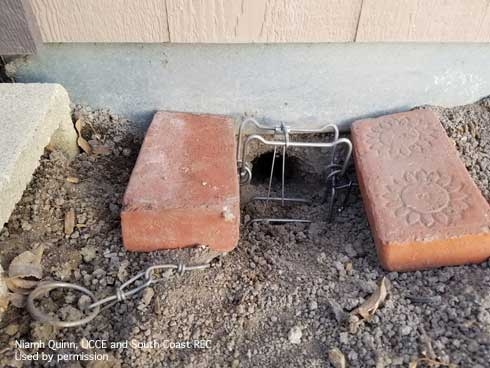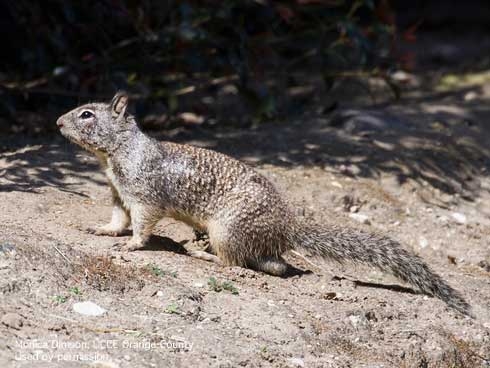Regardless of what type of management option you use, you must first consider whether there are endangered or threatened species present on the property that may use ground squirrel burrows (such as burrowing owls, tiger salamanders, etc.). To check if there are endangered species on your property and to learn about proper uses of pest management products when these species are present, you can consult the PRESCRIBE tool. Trapping may still be an option if there are endangered species present, as long as you use and properly set specific trap designs, ensuring that they are inaccessible to endangered species. After determining whether endangered or threatened species need to be considered, you need to think through the pros and cons of each method, as explained below.
Toxic Baits
There are two categories of toxic baits available for California ground squirrel control: first generation anticoagulant rodenticides (FGARs, which require multiple feedings) and zinc phosphide (an acute toxin that may only require a single feeding). Many toxic baits are restricted use pesticides. Anyone applying a restricted material must hold a pesticide applicator's license and will need a restricted use material permit. A notice of intent must be given to your county ag commissioner's department at least 24 hours before the application of a restricted use material. Applicators then have up to four days after the planned date (the date on the notice of intent) to begin the application; otherwise, a new notice of intent must be filed. A written recommendation from a Pest Control Advisor may also be required. If you have any questions about what permits or paperwork are required for using a particular rodenticide, check with your local Agricultural Commissioner's office.
In general, when applying any type of rodenticide, always read the label carefully. The label will specify how to apply the bait correctly, the timing of subsequent applications (if applicable), the target species for which the toxic bait can be used, and the locations permitted for use. You must always have a copy of the label with you on site when you apply rodenticides.
FGARs can be used as spot treatments, broadcast applications (though not for resident use), or in bait stations. There is an antidote (Vitamin K1) available for the active ingredients in FGARs, but, since it is not 100% effective and requires a prescription from a veterinarian, these products should not be applied if you have any concerns that nontarget animals will be able to access the bait. There is a primary risk of nontarget exposure from the use of FGARs, however it is generally necessary for it to be consumed over multiple days, on multiple occasions to achieve a toxic dose.
Zinc phosphide does not have an antidote available and can only be used as a spot treatment or a broadcast application (NO bait stations). It is not permitted for use in or around buildings, and the label is species-specific for many locations, so always double check the label before applying it. You must be a licensed pesticide applicator to use this toxic bait to manage California ground squirrels. It poses a higher primary toxicity risk (due to direct consumption) but a lower secondary toxicity risk (due to consumption of a poisoned animal) to nontarget animals than the FGARs.
When using toxic baits, you should check for and properly dispose of squirrel carcasses daily. Always wear gloves when handling carcasses.
Trapping

For multi-catch live traps, which allow you to catch multiple ground squirrels at once, it is very important to pre-bait. That means you should place bait within the trap for a few days without setting the trap and allow the ground squirrels to feed on the bait freely. Pre-baiting will get the older and potentially trap-shy ground squirrels more comfortable with the trap and will increase your odds of catching them once the traps are set. When doing any sort of trapping, you are ideally looking to catch the adults, not just the younger, typically less wary, individuals. If you are able to catch a mature individual, its alarm calls will act as a form of bait in and of itself and will attract other ground squirrels into the trap.
To avoid contacting squirrel urine or feces, wear gloves when handling any type of trap, even if the trap is empty. You are required by the California Department of Fish and Wildlife to check the traps at least once daily.
Traps must be set more than 150 yards from any structure used as a permanent or temporary residence, unless such traps are set by a person controlling such property or by a person who has and is carrying written consent of the landowner to place the trap or traps.
California ground squirrels, once trapped, must be immediately killed or released in the site where trapped. Unless released, trapped animals shall be euthanized following AMVA guidelines or by shooting where local ordinances, landowners, and safety permit.
For more detailed information on ground squirrel control and other control methods not mentioned here, check out ANR's online resources Pest Notes: Ground Squirrel and the Ground Squirrel BMPs website.
[Article originally published in the Summer 2021 issue of the Green Bulletin.]
